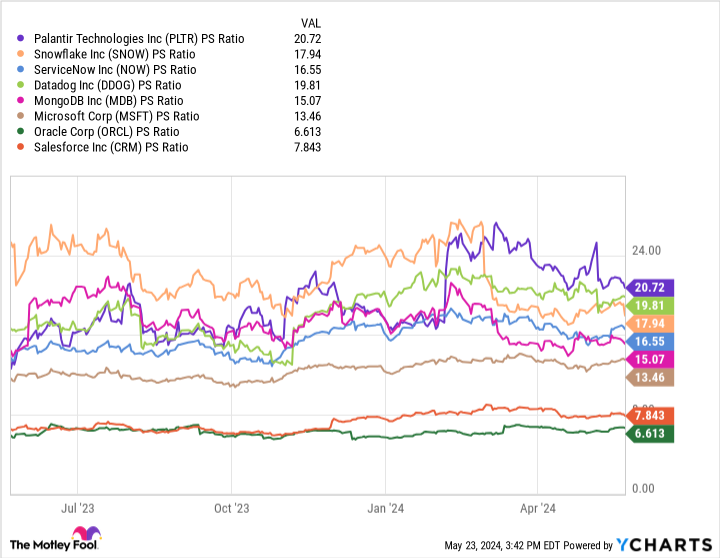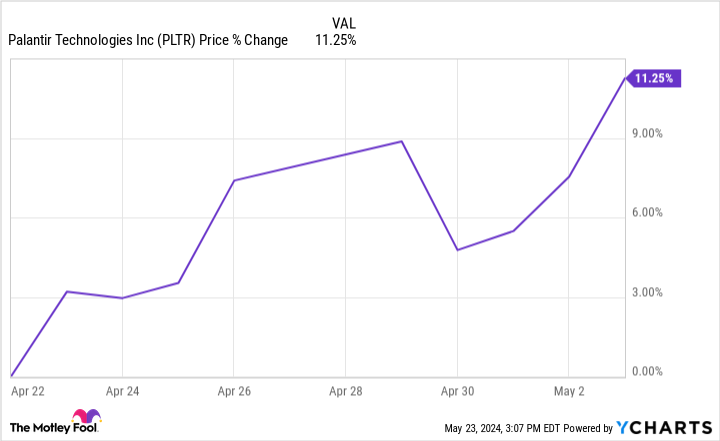The excitement around artificial intelligence (AI) can’t be understated. Technology stocks in particular soared in 2023, helping propel the Nasdaq Composite by 43%.
Last year, a small cohort of megacap technology companies collectively referred to as the “Magnificent Seven” played a major role in pushing the markets. However, a number of other opportunities are emerging outside of big tech as the AI revolution charges onward.
Shares of Palantir Technologies (NYSE: PLTR) soared 167% last year. Moreover, Palantir stock was up 36% this year prior to publishing first-quarter earnings on May 6.
But since the company’s earnings report in early May, shares of Palantir have cratered by 18%.
Is now a time to buy the dip, or could Palantir be a falling knife? Let’s take a look at the volatility in the stock price, and assess the company’s earnings report.
A close look at the stock movement
The chart below illustrates the movements in Palantir’s stock price for the two weeks leading up to its first-quarter earnings report.
Although 11% may not seem like much, this is a pretty dramatic movement in a short time frame. To put it into perspective, the entire Nasdaq index only moved 4.6% during this same time period. Furthermore, from Jan. 1 to May 3, the Nasdaq rose by 7.6%.
Considering that Palantir stock outperformed the Nasdaq’s year-to-date performance in just two weeks hints at something deeper.
Namely, sometimes before an earnings a report, a stock will begin to witness some momentum. While there are many reasons for this, I’d say that this outsize trading activity isn’t warranted most of the time.
Furthermore, momentum stocks often come with risk because day traders can enter and exit a position in a flash.

Expectations are sky high
Last year the stock market was heavily influenced by splashy investments that tech companies were making in AI. In other words, a lot of the AI narrative became priced into software stocks in particular — even though many of these business were yet to show much for their AI investments.
In April 2023, Palantir released its fourth major software product: the Palantir Artificial Intelligence Platform (AIP). Since its release, Palantir has ignited a new wave of customer acquisition, which has spurred impressive levels of revenue growth.
There is a lot of hype surrounding AIP, and Palantir has proven that it can compete with big tech at a high level. Furthermore, considering less than 50% of Palantir stock is held by large institutions, I think it’s clear that the company has become a fan favorite among the retail investor community.
Palantir continues to move the ball forward across its entire business. For the quarter ended March 31, Palantir increased revenue 21% year over year to $634 million.
Additionally, the company expanded its operating margin from 24% during the first quarter of 2023 to 36% at the end of the first quarter this year. The combination of accelerating revenue and rapidly expanding margins has resulted in consistently positive net income and free cash flow for Palantir.
Despite these positive indicators, Palantir stock has dropped sharply and remains at depressed prices. Excitement around the company’s progress in AI led to a fleeting period of increased buying activity. However, the expectations from investors are now at levels that are inconsistent with reality.
To be candid, Palantir’s current price action is showing signs more akin to that of a meme stock right now.
Is now a good time to invest in Palantir stock?
Despite some of the quirky characteristics of the stock, I see many reasons to invest in Palantir.
AIP has proven to be a new source of growth for Palantir — particularly in the private sector. During the first quarter, the company’s U.S. commercial customer count soared by 69% year over year. Moreover, the company is making inroads with big tech in terms of strategic alliances.
Palantir recently partnered with Oracle to bring its data loads to Oracle’s cloud infrastructure. I see this as a lucrative source of lead generation, and one that is yet to be recognized in Palantir’s current results.

At a price-to-sales (P/S) ratio of 20.7, Palantir stock trades at a premium to many of its enterprise software peers and even several big tech AI businesses. While this shows that Palantir shares aren’t dirt cheap, the trends seen in the chart above illustrate that Palantir’s valuation multiples have become more normalized thanks to the sell-off.
Even though Palantir stock is a bit pricey, I’d still consider scooping up shares. The company has made measurable progress over the last year, and with soaring sales and profits Palantir represents a unique opportunity among high-growth AI software businesses.
Should you invest $1,000 in Palantir Technologies right now?
Before you buy stock in Palantir Technologies, consider this:
The Motley Fool Stock Advisor analyst team just identified what they believe are the 10 best stocks for investors to buy now… and Palantir Technologies wasn’t one of them. The 10 stocks that made the cut could produce monster returns in the coming years.
Consider when Nvidia made this list on April 15, 2005… if you invested $1,000 at the time of our recommendation, you’d have $697,878!*
Stock Advisor provides investors with an easy-to-follow blueprint for success, including guidance on building a portfolio, regular updates from analysts, and two new stock picks each month. The Stock Advisor service has more than quadrupled the return of S&P 500 since 2002*.
See the 10 stocks »
*Stock Advisor returns as of May 28, 2024
Adam Spatacco has positions in Microsoft and Palantir Technologies. The Motley Fool has positions in and recommends Datadog, Microsoft, MongoDB, Oracle, Palantir Technologies, Salesforce, ServiceNow, and Snowflake. The Motley Fool recommends the following options: long January 2026 $395 calls on Microsoft and short January 2026 $405 calls on Microsoft. The Motley Fool has a disclosure policy.
Palantir Stock Is Cratering, but the Reason Why May Surprise You (Hint: It’s Not Because of Artificial Intelligence Competition) was originally published by The Motley Fool
Credit: Source link




